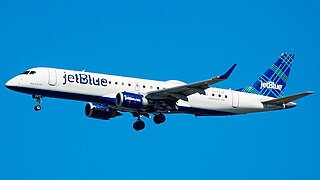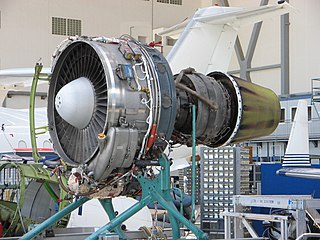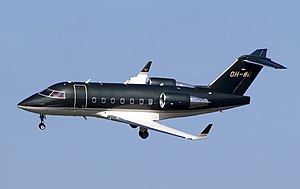
A business jet, private jet, or bizjet is a jet aircraft designed for transporting small groups of people, typically business executives and high-ranking associates. Business jets are generally designed for faster air travel and more personal comfort than commercial aircraft, and may be adapted for other roles, such as casualty evacuation or express parcel deliveries, and some are used by public bodies, government officials, VIPs, or even the armed forces.

Canadair Ltd. was a civil and military aircraft manufacturer in Canada. In 1986, its assets were acquired by Bombardier Aerospace, the aviation division of Canadian transport conglomerate Bombardier Inc.

The Learjet 60 is a mid-size cabin, medium-range business jet aircraft manufactured by Bombardier Aerospace in Wichita, Kansas. Powered by two Pratt & Whitney Canada PW305A engines, it has a range of 2,405 nautical miles (4,454 km) with NBAA 100 nmi (190 km) reserves, ISA. In July 2012 Bombardier Aerospace announced a temporary "production pause" of the latest variant Learjet 60XR to begin in the fourth quarter of 2012.

Learjet was a manufacturer of business jets for civilian and military use based in Wichita, Kansas, United States. Founded in the late 1950s by William Powell Lear as Swiss American Aviation Corporation, it became a subsidiary of Canadian Bombardier Aerospace in 1990, which marketed the company’s aircraft as the "Bombardier Learjet Family". The 3,000th Learjet was delivered in June 2017. The Learjet line was once sufficiently popular that the Learjet name became synonymous and interchangeable with the terms business jet or private jet in the popular vernacular. In February 2021, Bombardier announced the end of production for all new Learjet aircraft in 2021, with the continuation of support and maintenance for aircraft currently in service.

The Embraer E-Jet family is a series of four-abreast, narrow-body, short- to medium-range, twin-engined jet airliners designed and produced by Brazilian aerospace manufacturer Embraer.

The Bombardier Global Express is a large cabin, long-range business jet designed and manufactured by Bombardier Aviation. Announced in October 1991, it first flew in October 1996, received its Canadian type certification in July 1998 and entered service in July 1999. Initially powered by two BMW/Rolls-Royce BR710s, it shares its fuselage cross section with the Canadair Regional Jet and Challenger 600 with a new wing and tail.

The Airbus A220 is a family of five-abreast narrow-body airliners by Airbus Canada Limited Partnership (ACLP). It was originally developed by Bombardier and had two years in service as the Bombardier CSeries. The program was launched on 13 July 2008. The smaller A220-100 made its maiden flight on 16 September 2013, was awarded an initial type certificate by Transport Canada on 18 December 2015, and entered service on 15 July 2016 with launch operator Swiss Global Air Lines. The longer A220-300 first flew on 27 February 2015, received an initial type certificate on 11 July 2016, and entered service with airBaltic on 14 December 2016.

The Canadair CL-415 and the De Havilland Canada DHC-515 are a series of amphibious aircraft built originally by Canadair and subsequently by Bombardier and Viking Air, and De Havilland Canada. The CL-415 is based on the Canadair CL-215 and is designed specifically for aerial firefighting; it can perform various other roles, such as search and rescue and utility transport.

The Bombardier Challenger 300 is a 3,100-nautical-mile range super mid-sized business jet designed and produced by the Canadian aircraft manufacturer Bombardier Aerospace.

The Embraer Legacy 600 is a business jet derivative of the Embraer ERJ family of commercial jet aircraft.

The Canadair CL-44 was a Canadian turboprop airliner and cargo aircraft based on the Bristol Britannia that was developed and produced by Canadair in the late 1950s and early 1960s. Although innovative, only a small number of the aircraft were produced for the Royal Canadian Air Force (RCAF), and for commercial operators worldwide.

A regional jet (RJ) is a jet-powered regional airliner with fewer than 100 seats. The first one was the Sud-Aviation Caravelle in 1959, followed by the widespread Yakovlev Yak-40, Fokker F-28, and BAe 146. The 1990s saw the emergence of the most widespread Canadair Regional Jet and its Embraer Regional Jet counterpart, then the larger Embraer E-Jet and multiple competing projects. In the US, they are limited in size by scope clauses.

The Bombardier Challenger 800 is the largest super-midsize business jet that was built by Bombardier Aerospace. It is based on Bombardier's 50-seat Bombardier CRJ200 LR. The Challenger 850 is the updated version, produced from 2006 to 2012.

The General Electric CF34 is a civilian high-bypass turbofan developed by GE Aircraft Engines from its TF34 military engine. The CF34 is used on a number of business and regional jets, including the Bombardier CRJ series, the Embraer E-Jets, and Comac ARJ21. In 2012, there were 5,600 engines in service.

The Canadair North Star is a 1940s Canadian development, for Trans-Canada Air Lines (TCA), of the Douglas DC-4. Instead of radial piston engines used by the Douglas design, Canadair used Rolls-Royce Merlin V12 engines to achieve a higher cruising speed of 325 mph (523 km/h) compared with the 246 mph (396 km/h) of the standard DC-4. Requested by TCA in 1944, the prototype flew on 15 July 1946. The type was used by various airlines and by the Royal Canadian Air Force (RCAF). It proved to be reliable but noisy when in service through the 1950s and into the 1960s. Some examples continued to fly into the 1970s, converted to cargo aircraft.

The Bombardier CRJ100 and CRJ200 is a regional jet designed and manufactured by Bombardier Aerospace between 1991 and 2006, the first of the Bombardier CRJ family.

The Bombardier CRJ550, CRJ700, CRJ705, CRJ900, and CRJ1000 are a family of regional jet airliners that were designed and manufactured by Canadian transportation conglomerate Bombardier between 1999 and 2020. Their design was derived from the smaller CRJ100 and 200 airliners, the other members of the Bombardier CRJ aircraft family. The CRJ program was acquired by the Japanese corporation Mitsubishi Heavy Industries in 2020, which ended production of the aircraft.

The Lycoming ALF 502/LF 507 is a geared turbofan engine produced by Lycoming Engines, AlliedSignal, and then Honeywell Aerospace. The U.S. military designation for the ALF 502 is YF102.

The General Electric Passport is a turbofan developed by GE Aerospace for large business jets. It was selected in 2010 to power the Bombardier Global 7500 and 8000, first run on June 24, 2013, and first flown in 2015. It was certified in April 2016 and powered the Global 7500 first flight on November 4, 2016, before its 2018 introduction. It produces 14,000 to 20,000 lbf of thrust, a range previously covered by the General Electric CF34. A smaller scaled CFM LEAP, it is a twin-spool axial engine with a 5.6:1 bypass ratio and a 45:1 overall pressure ratio and is noted for its large one-piece 52 in (130 cm) fan 18-blade titanium blisk.

The Dassault Falcon 30 was a prototype French jet-powered regional airliner of the 1970s. It was developed by Dassault Aviation from its successful Falcon 20 business jet, and was larger with more powerful engines, with capacity to carry 40 passengers. A single prototype was built, flying for the first time on 11 May 1973, but no production followed.





































